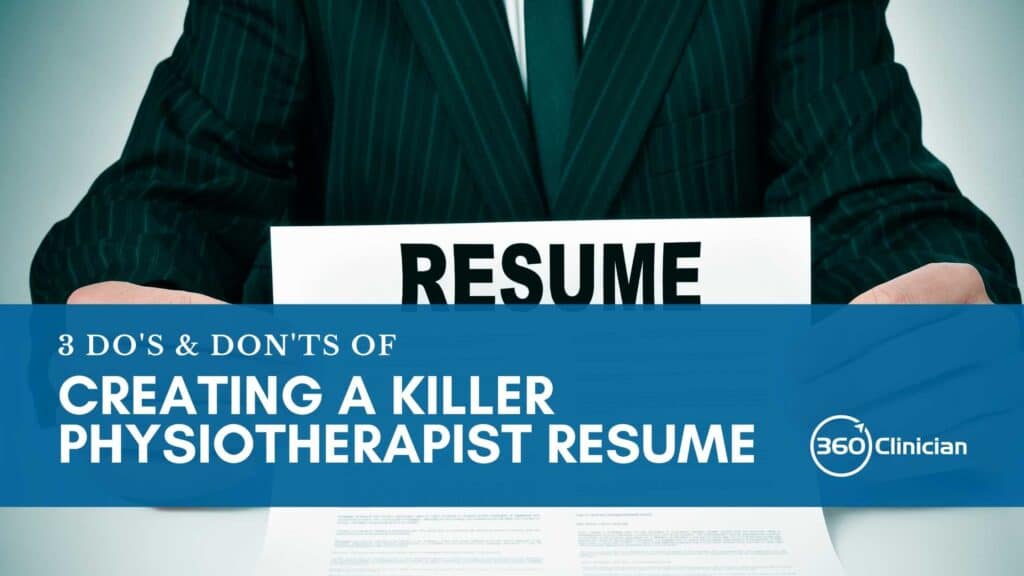If you’re an internationally educated physiotherapist (or a new grad!) trying to secure yourself a position in Canada, the first thing you’ll want to fine-tune is your resume.
Here are some ways to ensure you’re showing yourself in the best light – and what to avoid.
The Right PT Job Starts with a Great Resume
Establishing yourself as a physiotherapist in a new country can feel like starting all over again. While you grapple with the challenges of adapting to a new culture, you have to find a way to promote yourself and make a lasting impression. To secure a new job, the first thing you’ll want to fine-tune is your resume. Here are some ways to ensure you’re showing yourself in the best light – and what to avoid.
DO target your prospective employer
Sending out cut-and-paste, one-size-fits-all resumes and cover letters communicates to your employers that you’re not that concerned with their specific organization. Likewise, uninspired template statements will do nothing to get you hired.
Solution: Make sure you tailor a targeted cover letter/statement paragraph for each application. Do this by researching the employer well and adapting your skills and attributes to match. This is a respectful way to be mindful of your employer’s time and only present the information that they’ll really be looking for.
Research the way the employment setting or clinic is run, the educational background of the staff and the image they like to portray. You can safely remove items from your resume if they’re not relevant, and instead expand on those areas that your potential employer will be interested in. It pays to also mention why exactly you want to apply to that particular clinic.
- Tip: find out what the clinic specializes in and if you have any relevant training and experience in this area, list it first.
DO be thorough, yet concise
Think about hiring from the employer’s perspective: they need to process possibly dozens of applications and quickly weed out the unsuitable candidates. Do your prospective employers a favour and make it easy for them to read your resume and access the information they’re looking for.
Solution: Try to preempt the questions your employer will have as they scan your resume, then make sure you are answering them. Put appropriate biographical information at the top in an easy-to-read format, and start the resume with your strongest features.
If you’re a newer gradudate, start with your education, as you may not yet have much experience. If you’re a seasoned physiotherapist, start with a list of past positions and put your education second.
Be specific about exactly what each course or position entailed. Keep things succinct but don’t be tempted to leave out important information. Things like marital status, High School test scores or a photograph are generally not seen as necessary information. As for length, keep it down to a page if you’re just starting out, and don’t go beyond around two and a half pages if you’re more experienced. Ensure that all information can be verified as needed.
DO pay attention to the little things
If your resume is a representation of who you are, then sloppiness, spelling mistakes and poor formatting make you look careless.
Solution: Proofread everything a few times and get someone else to read it over and give you a second opinion, too. Make sure the style and design of the resume is clean and simple, and don’t overwhelm the reader with too many fonts, colours or clutter on the page. Double check things like phone numbers and exact dates of courses.
- Tip: check that you use correct Canadian spelling (i.e. “colour” and not “color”) and avoid any regional idioms or phrases.
DON’T be too humble
Particularly for newer graduates, self-promotion can feel a little awkward. But a resume is, to put it bluntly, selling you as a physiotherapist. So don’t be too shy about marketing yourself! Avoid “mousey” language in cover letters. This means cutting out language like “I’m would really appreciate it if…” or “I hope you don’t mind…” or “I’m so sorry, but…”. This makes you look unsure and unconfident.
Solution: If you’re good at something, say so.
DON’T make any assumptions
It will take some time to get acquainted with certain cultural norms and the healthcare system, so to start, avoid making any assumptions. This means spelling out your qualifications clearly if you earned them abroad, and making sure that you’re using standard vocabulary and technical terms that your potential employers will be familiar with.
Solution: Briefly tell the reader precisely what you learnt in each course, not just the course title. Don’t assume they’ll know what you did in previous roles – lay it out for them. Be explicit about the exactresponsibilities you had, and remember to include your interactions with both patients and other staff members.
The standards and norms in a Canadian organization might be very different to what you’re used to, so make it easy for your employers to understand just what your past titles meant and how that translated to your patients. Take care to highlight any experience you’ve had with diverse and multicultural populations.
- Tip: Follow a problem-solution model: list a skill you applied in context and explain the results you got and how this benefitted your previous employers.
DON’T be boring
Of course, resumes are professional documents, but don’t be afraid of showcasing your unique personality. In fact, your resume may garner more attention if it’s easy to see the human being behind the qualifications. You probably will be up against similarly qualified applicants, so try to stand out by showing what makes you different from them.
Solution: Paint a picture of a well-rounded person in your resume. Make sure you are showing some sort of competence in every area of care, and add in any experience with other disciplines, as well as an explanation of how those skills translate to physiotherapy.
Physiotherapists need to have solid physiotherapy education and training and convey trust to their clients – but they also have to be personable and genuinely caring, so make sure this comes through on your resume. Briefly note other courses you’ve done, even publications and awards, and, if you find an opportunity, throw in a line or two about why physiotherapy is your passion in the first place.
- Tip: don’t merely list jobs and roles – use verbs in the active tense to draw attention to what you actually did, rather than the passive roles you held.
Of course, a resume is not a static thing. As you develop your career as a physiotherapist, and as you slowly add to your expertise, your resume will change and adapt. Regularly re-appraise your goals to make sure that you’re still conveying the right message, and tweak it with every new application.
Resume Building Resources
- Alberta Learning Information Service (ALIS)
- CAPS: University of Alberta Career Centre
- Settlement.org (for Ontario, but applicable to all over Canada)
- Government of Canada Youth Services


